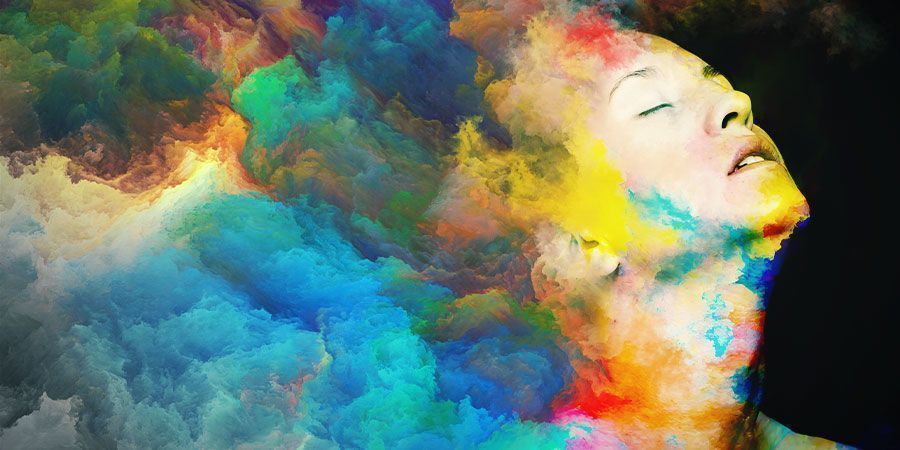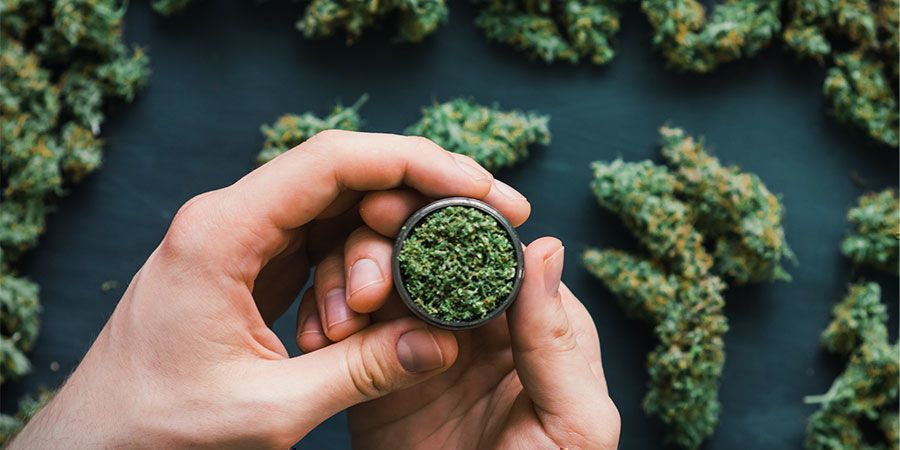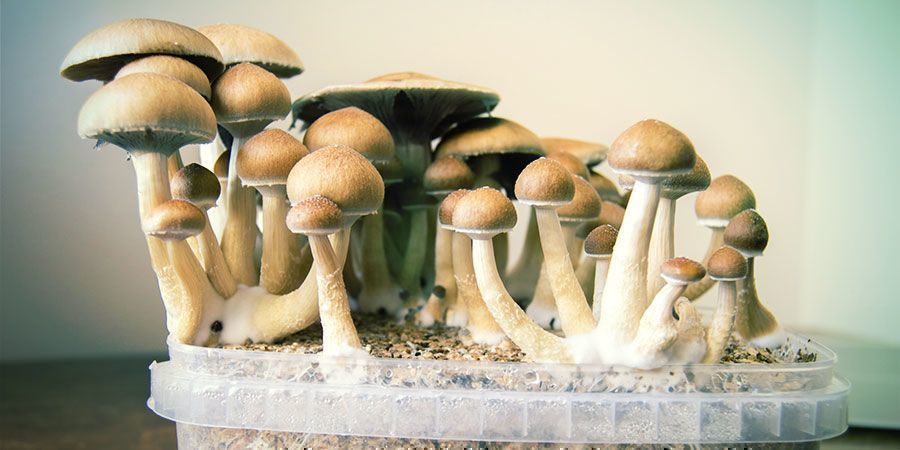The Three Main Types of Psychedelics

Classical psychedelics, empathogens, and dissociatives each possess a unique set of effects, ranging from warm euphoria to vivid visuals and dissociative sensations.
Humans have been fascinated with psychedelics for what seems like forever. From intense introspective trips to spiralling visuals and profound states of euphoria, it seems no two experiences are the same. Some, however, are more alike than you’d think.
How to Categorise Different Psychedelics
Gather the world's most popular psychedelics in one room, and you'll quickly find they share some striking similarities. They might not look alike, but many of them will have the same general set of effects as one another. By profiling said effects, we can assign these substances into three distinct groups—classical psychedelics, empathogens, and dissociatives. As we go on, we’ll offer a summary of each group, discuss their general effects, and give a breakdown of well-known members.
Classical Psychedelics (Serotonergic Psychedelics)

Classical psychedelics will be what most people think of when they hear the term “psychedelic”. Scientifically, they’re known as serotonergic substances, and while that term is less familiar, it offers insight into how they work. As you might guess, the term stems from the influence of classical psychedelics over our serotonin system. Many are naturally occurring (vines, mushrooms, and leaves), but there are a handful of synthetic variants as well.
Most psychonauts tend to start with classical psychedelics because they have a softer dose curve. The experience itself isn’t necessarily soft, though, as changes in perception, mood, and sensory experience ramp up with higher doses.
Discovery and History of Classical Psychedelics
The use of classical psychedelics extends as far back as 55 million years, at least according to the "stoned ape" theory. Terence McKenna, the author behind said theory, hypothesised that Psilocybe mushrooms—a key player in the classical psychedelics category—performed a crucial role in the evolution of humans. In other words, magic mushrooms helped expand the minds of our ancestors, influencing the way we think and feel today.
Since then, cultures across the world have continued to show a deep fascination with the power of classical psychedelic substances. Even as they’ve expanded outside their traditional settings and been put under the microscope, it seems we've yet to uncover the full potential of classical psychedelics.
Effects of Classical Psychedelics
As we’ve discussed, serotonergics are unified by their effects. While specific ones differ in intensity, classical psychedelics typically generate changes in perception, mood, and the way we process information.
Common effects include:
- Distorted perception of time
- Alterations to vision (colour shifting, drifting, and visual flipping or stretching)
- Enhancement of mood, thought, and awareness
Given these effects, it’s clear to see why classical psychedelics are not just enjoyed by those seeking enlightenment, but by those wanting to increase their creativity, productivity, and sociability as well.
Things to Consider With Classical Psychedelics
While classical psychedelics are united in their effects, individual experiences are influenced by dozens of factors. Remember, no two trips are the same, and it's important not to underestimate the influence of serotonergics.
You shouldn't mix different classical psychedelics, or combine them with other substances such as alcohol. If it's your first time, or you're trying something new, a trip sitter is invaluable. In turn, carefully consider where and when you want to trip. Lastly, remember classical psychedelics heavily influence sensory perception, so your environment should make you feel as comfortable as possible.
Well-Known Classical Psychedelics
There are many out there, but these are the most common classical psychedelics you’ll find.
-
Mescaline
Mescaline is a psychedelic alkaloid typically found in the flesh of peyote, San Pedro, and Peruvian torch cacti. Native to Mexico and South America, they have a long and rich history of indigenous use. It takes a bit of preparation from the raw state, but the final result is a powerful serotonergic. When prepared correctly, the mind-bending effects of mescaline typically last 8–12 hours. Fortunately, it's easy to grow from a cutting, and only a small amount is needed to initiate a strong experience.
-
DMT
Want to venture on a psychonautic journey, but have a busy schedule? You’ll be in and out of your trip before you know it with DMT (or N,N-dimethyltryptamine for the scientifically savvy). The substance is a potent classical psychedelic, available naturally from several plant species, and also artificially (from a lab). DMT encompassess all of the typical psychedelic effects, and provides out-of-body experiences at the right dose. What’s better, it’s all said and done in about 10–20 minutes (depending on the method of intake)!
-
Psilocybin
Psilocybin mushrooms are one of the oldest known classical psychedelics, with a history spanning thousands of years and dozens of cultures. For that reason, when most people think of psychedelics, magic mushrooms are usually the first drug that comes to mind. It's hardly surprising, though. A mere 1–2 grams of dried Psilocybe cubensis is enough to induce vivid changes to visual and auditory perception. When you then consider they grow all over the world, their popularity starts to make even more sense.
-
LSD
Unlike the other serotonergic drugs, LSD is exclusively synthetic—meaning it’s artificially produced in a lab. It was originally created by Albert Hofmann (who didn't realise what he'd done at first), and would later become part of a secret CIA mind-control experiment called MKUltra. Despite the backstory sounding like a movie script, LSD was very real, and very popular. It rose to prominence in the 1960s, favoured for producing intense feelings of euphoria and vibrant visual hallucinations. The drug is usually ingested orally, with trips lasting around 12 hours.
Empathogens

Relative to classical psychedelics, empathogens are less dramatic in effects. Visual and auditory changes are far milder, with a greater focus on emotional and social effects.
Empathogens have a strong reputation as party drugs, namely because they increase sociability, friendliness, and, as their name implies, empathy. You may also see empathogens referred to as entactogens. The change in name merely removes negative connotations associated with the Greek root "pathos", meaning suffering.
Discovery and History of Empathogens
The most common drug in the empathogen category is MDMA, while others include MDA, MDEA, and mephedrone. 3,4-methylenedioxymethamphetamine (MDMA) was first developed in 1912, but it only became a big part of psychotherapy in the 1970s, finally hitting the streets in the 80s.
On a chemical level, empathogens are a bit of a hybrid, with qualities of both stimulants and psychedelics. Given that mix of characteristics, empathogens became an obvious choice for the rave scene. These substances are popular at parties, festivals, and clubs, but aren't a purely recreational substance. In fact, over the years, many studies have sought to determine the potential of substances like MDMA on various psychological conditions.
Effects of Empathogens

Empathogens take a little while to kick in, but when they do, expect to feel the following:
- Euphoria
- Increased friendless and benevolence towards others
- Heightened sensitivity to emotional and visual stimuli
The effects of empathogens usually start after 30–50 mins, reaching their peak after roughly two hours.
Things to Consider With Empathogens
The stimulant nature of empathogens means increased perspiration, and with that comes a risk of dehydration. Mixing other substances with empathogens is not recommended, especially alcohol as it only exacerbates dehydration. Although it may seem tempting to combine empathogens with other psychedelics, doing so is more likely to catapult you into a bad trip.
Well-Known Empathogens
We’ve discussed some already, but here’s a breakdown of the most well-known empathogens.
-
MDMA
MDMA is by far the most popular member of the empathogen category. The drug is also known as ecstasy, E, X, or molly. The latter usually refers to a pure crystalline powder, while the former is MDMA in tablet form. No matter the name, the effects are the same—heightened empathy. It is these intense feelings of sympathy, empathy, and mild visual distortion that make MDMA a popular choice for ravers.
-
Ethylone (Khat)
Ethylone is part of a group of substances whose chemical structure mimics that of cathinone, a natural alkaloid found in the Khat genus. However, it remains different enough that the same legal restrictions don't apply. Ethylone is a potent stimulant, favoured for producing effects similar to that of mephedrone (M-cat). It's also relatively new to the empathogen category. In fact, its creation is so recent that there's a distinct lack of understanding regarding its effects and long-term influence, so be careful!
Dissociatives

Looking for an out-of-body experience? It may be time to explore the world of dissociatives. Perhaps the most intimidating of the three, dissociatives have taken the longest to become popular. Yes, they’re psychedelics in a general sense, but the experience is unique in terms of how it manipulates perception.
Firstly, dissociatives are marked by the intense sensory distortion they cause. It's common for users to feel detached from reality. However, as fun as that may sound, don't take the effects lightly. When we say detached from reality, we mean the environment, people, and even yourself!
Discovery and History of Dissociatives
It's hard to pinpoint an exact history of dissociatives, as the category includes a slew of natural and synthetic substances. On the artificial side, you have drugs such as ketamine, PCP, and nitrous oxide. All three have risen in popularity since the mid-90s, but it’s not all fun and games. Both ketamine and PCP can cause an abundance of long-term health issues, not to mention total ego death in extreme cases.
Perhaps the most well-known natural dissociative, Salvia divinorum, has an intriguing history among Mazatec shamans. Even today, the plant is still used in ceremonies and rituals throughout the forests of Oaxaca, Mexico. In fact, interest in salvia has actually grown, with psychonauts all over the world keen to experience the otherworldly sensation.
Effects of Dissociatives

As we've highlighted above, dissociatives are defined by a profound disconnect from the world around you. Effects typically manifest as the following:
- Out-of-body experience
- Ego death
- Vivid hallucinations
- Communication with otherworldly beings
Now, don’t quote us on that last one. Although we can neither confirm nor deny communication with otherworldly beings, speaking to divine entities is a frequently claimed experience among users of dissociatives—especially natural variants like salvia.
Things to Consider With Dissociatives
If we haven't stressed it enough already, dissociatives are for the experienced psychonaut. While nothing is stopping you trying them as a first-timer, you'll likely to become overwhelmed. As always, the key to any successful or enriching psychedelic experience is set and setting. With substances as influential as salvia or N₂O, preparing a safe tripping area and finding an experienced trip sitter are both key.
Finally, dissociatives are plenty powerful enough on their own, so it should go without saying that you don't want to mix them with any other mind-altering substances.
Well-Known Dissociatives
There are numerous well-known dissociatives, and different ones rise and fall in popularity based on their unique appeal and availability.
-
Salvia divinorum

Sage of the Diviners, Seer's Sage, or Yerba de la Pastora is a profoundly symbolic dissociative with a powerful arsenal of psychedelic effects. But, its use has moved past spiritual rituals, with Salvia divinorum now available worldwide. You can crush or chew the leaves, smoke it, or use the leaf juice in tinctures. While the consumption method alters the duration of effects and their intensity, it doesn't change the outcome—a potent spiritual journey aptly titled a "gift from the gods".
-
N₂O
N₂O, or nitrous oxide, has made a name for itself as "laughing gas". Common in dentistry (which, ironically, is usually no laughing matter), this dissociative causes strong euphoria and an out-of-body floating sensation. But, despite its reputation as a recreational drug, N₂O remains an Essential Medicine under World Health Organisation mandate. N₂O is non-toxic, and by all accounts appears relatively safe to use. There is, however, a risk of harm from incorrect use. N₂O canisters are pressurised, and contact with the liquefied gas on the skin or eyes can be dangerous.
What About Cannabis? Does It Fall Into the Psychedelic Category?

The question of whether cannabis is classified as a psychedelic is a fiercely debated one. Academics argue that psychedelics are defined by their biological reaction—how they bind with receptors in the human body. In this case, it's easy to separate cannabis and psychedelics because the mechanism of action differs. If, however, you compare the effects, both psychedelics and cannabis suddenly show a lot of similarities. Marijuana isn’t nearly as intense, but several of the milder effects (changes in visual and auditory perception, euphoria, and empathy) are typical with cannabis use.
Cannabis has the potential to alter how we think and feel, which, while not as profound as psychedelics, is an alteration nonetheless. For now, the debate on whether cannabis as a psychedelic remains a contested one. But, if you're interested in exploring the argument for yourself, why not check out our Top 10 Psychedelic Cannabis Strains? You never know, your insight might help finally uncover a definitive answer.
You might also like













 United States
United States
























